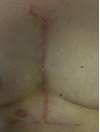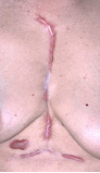Presentation and management of keloid scarring following median sternotomy: a case study
- PMID: 21122137
- PMCID: PMC3009623
- DOI: 10.1186/1749-8090-5-122
Presentation and management of keloid scarring following median sternotomy: a case study
Abstract
Introduction: Keloid scars following median sternotomy are rare and occur more frequently in pigmented skin. Different management strategies have been described with variable success. We present a case of keloid scar formation following cardiac surgery including our management and the final aesthetic result.
Case description: A 64 year old female of fair complexion underwent mitral valve replacement. The procedure and postoperative recovery were uncomplicated, however, during the following year, thick keloid scars formed over the incision sites. Initial non surgical measures failed to relieve pain and did not offer any tangible aesthetic benefit. Eventually surgical excision was attempted. She presented to our clinic for nine months follow up with significant improvement in pain and aesthetic result.
Discussion and evaluation: Several theories have attempted to explore the pathophysiology of keloid scar formation. A number of predisposing factors have been documented however none existed in this case. A variety of invasive and non invasive approaches have been described but significant differences in success rates and methodology of investigations still precludes a standardized management protocol.
Conclusions: In this case study a rare presentation of keloid scar has been presented. The variety of methods used to improve pain and aesthetic result demonstrates the propensity of keloid scars to recur and the therapeutic challenges that surgeons have to face in their quest for a satisfactory patient outcome.
Figures





References
Publication types
MeSH terms
LinkOut - more resources
Full Text Sources

